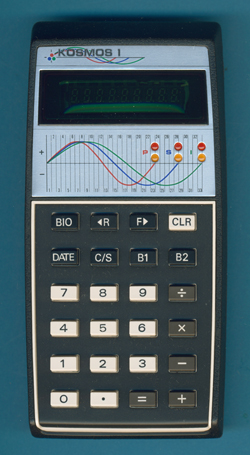
DATAMATH CALCULATOR MUSEUM
 |
DATAMATH CALCULATOR MUSEUM |
Kosmos 1
| Date of introduction: | 1977 | Display technology: | Fluorescent + 6 LED's |
| New price: | Display size: | 8 | |
| Size: | 5.6" x 2.8" x
1.1" 142 x 72 x 27 mm3 |
||
| Weight: | 4.3 ounces, 122 grams | Serial No: | 7046056 B |
| Batteries: | 3*AA | Date of manufacture: | mth 04 year 1977 |
| AC-Adapter: | Origin of manufacture: | Japan | |
| Precision: | 8 | Integrated circuits: | TMC1170NL/ZA0541
or TMC1172NL |
| Memories: | |||
| Program steps: | Courtesy of: | Joerg Woerner | |
| Download manuals: | |

![]()
 Kosmos
International, Inc.
based in Atlanta, Georgia introduced already in the year 1977 this pocket-sized biorhythm calculator.
Kosmos
International, Inc.
based in Atlanta, Georgia introduced already in the year 1977 this pocket-sized biorhythm calculator.
On a first glance you notice the [BIO] key on the calculator keypad and the three „sine-waves“ representing our:
| • Physical Cycle (P) • Emotional Cycle (S) • Intellectual Cycle (I) |
Learn more about the biorhythms here.
At the second thought you might ask yourself: Is there any relation of the Kosmos 1 to Texas Instruments?


 Dismantling this Kosmos 1 biorhythm
calculator manufactured in April 1977 in Japan reveals a very well engineered design centered around a Texas Instruments 4-bit single-chip microcomputer.
Dismantling this Kosmos 1 biorhythm
calculator manufactured in April 1977 in Japan reveals a very well engineered design centered around a Texas Instruments 4-bit single-chip microcomputer.
Texas Instruments invented the microcomputer and introduced in the year 1974 with the TMS1000 the first commercial product. The TMS1001 was the first LSI MOS chip of the TMS1000 family used in the Texas Instruments SR-16 calculator. The chip contains a microcomputer complete with a program ROM having 1,024 eight-bit words; a temporary storage RAM; input (from keypad); output (to control keypad scan and LED display); and an oscillator (clock). Within the next months a lot of variants of the TMS1000 appeared, including display driver, higher memory capacity and more input/output connections.
This Kosmos 1 biorhythm calculator is basically an application program "ZA0541" running on a TMS1100 microcontroller with 2,048 bytes of ROM and 128 x 4 bits of RAM.
 Learn more
about the internal design of the Kosmos 1 and study the United States Patent
Application US4184202
with the Title of Invention BIORHTYHM COMPUTER
and filed on February 22, 1978 by Kosmos International, Ltd., Nassau, The
Bahamas.
Learn more
about the internal design of the Kosmos 1 and study the United States Patent
Application US4184202
with the Title of Invention BIORHTYHM COMPUTER
and filed on February 22, 1978 by Kosmos International, Ltd., Nassau, The
Bahamas.
Kosmos introduced a special edition of the Kosmos 1 for the "Enlightened Woman" as
Love Machine in a beautiful red housing.
Calculator collector Noel Joenne reported recently that his red Kosmos 1 makes use of an Texas Instruments TMC1172 microcontroller with a date code of week 23 in the year 1977.
The next product in the Kosmos line are the Kosmos 2 and the Astro – the toy of your fortune-teller.
Biorhythms are inherent cycles which regulate metabolism, coordination, emotions, sexuality, memory, and more. We have 3 fundamental biorhythm cycles. Each biorhythm cycle has a particular life span.
Our physical cycle completes one life span (or cycle) in 23 days. The emotional
cycle lasts 28 days, and the intellectual cycle lasts 33 days.
At mid point, and end point in each cycle, the cycle sharply moves back to zero
point and changes polarity, thus creating a transition day (also called a
critical day, or caution day). That's all there is to it! As each cycles
changes polarity, we experience life's ups and downs!
Biorhythm cycles are as follows:
| • Physical Cycle (RED) 23 days
The physical cycle is the dominant cycle in men. It regulates hand-eye coordination, strength, endurance, sex drive, initiative, metabolic rate, resistance to, and recovery from illness. Surgery should be avoided on physical transition days and during negative physical cycles. • Emotional Cycle (BLUE) 28 days The emotional cycle is the dominant cycle in women. It regulates emotions, feelings, mood, sensitivity, sensation, sexuality, fantasy, temperament, nerves, reactions, affections and creativity. • Intellectual Cycle (GREEN) 33 days The intellectual cycle regulates intelligence, logic, mental reaction, alertness, of direction, decision-making, judgment, power of deduction, memory, and ambition. |
(Information about biorhythms provided by Jackie Stahl, www.biorhythmcalendar.com. Thanks!)
If you have additions to the above article please email: joerg@datamath.org.
© Joerg Woerner, February 10, 2002. No reprints without written permission.